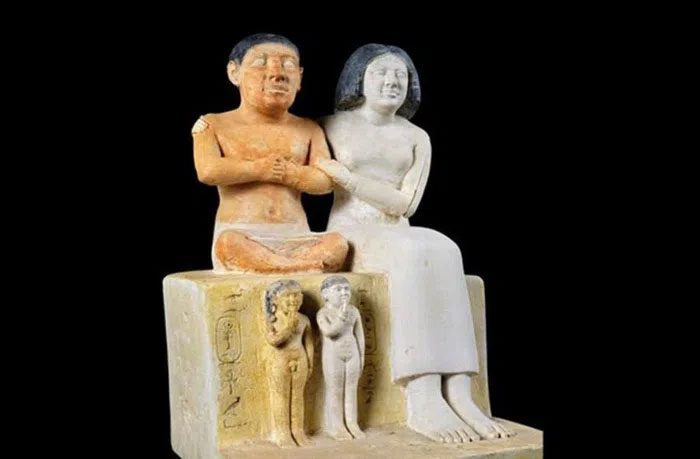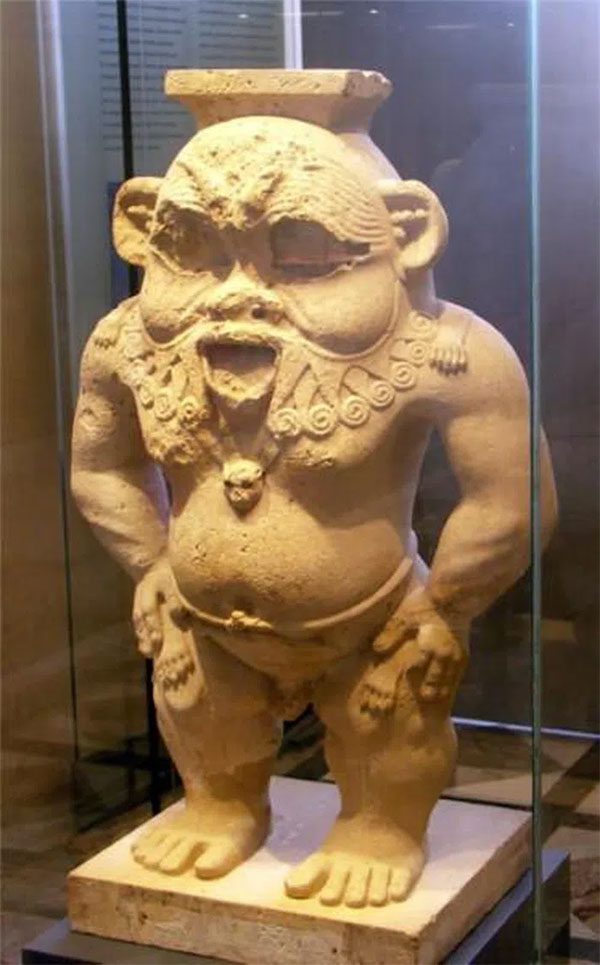While the ancient Greek, Roman, and Chinese cultures often mocked or even enslaved individuals with dwarfism, in ancient Egypt, dwarfs were respected and lived lives of luxury. Sometimes, they even became powerful figures within society.
High Status
The complex hieroglyphic system of the Egyptians, depicted and carved on architectural structures, art, and crafts, has provided modern researchers with deep insights into the daily lives of the people in this region.

The family statue of Seneb, a high-status dwarf in ancient Egypt.
Numerous broken stone slabs and ancient texts have revealed images depicting individuals suffering from achondroplasia—a disorder that causes disproportionate dwarfism.
According to Professor Chahira Kozma in her 2006 paper “Dwarfs in Ancient Egypt”, Egypt holds significant information about achondroplasia in the ancient world, with remains of dwarfs, including complete or partial skeletons.
There exists a form of ancient Egyptian literature known as “wisdom literature”, which emerged during the Middle Kingdom and became a standard in the New Kingdom. Writings from that era included moral teachings and emphasized that dwarfism should not be considered a physical defect.
Historian Betty Adelson notes that dwarfs in ancient Egypt had a “close relationship” within society, and thus, those who possessed them were viewed as high-status individuals.
In medieval European cultures, dwarfs were often seen alongside kings and queens during ceremonies or in public, as they would make royalty appear larger than life. In contrast, in ancient Egypt, dwarfs typically worked as jewelers, attendants, caregivers for animals, and entertainers.
According to a thesis published in 1972 by the Department of Orthopedics and Orthopedic Diseases in ancient and modern Egypt, dwarfs were depicted on the walls of “at least 50 tombs from the Old Kingdom (2700 – 2190 BC) near the pyramids at the vast cemeteries of Saqqara and the Giza plateau.”
Some dwarfs in the Old Kingdom held high social status, such as Seneb, Pereniankh, Khnumhotpe, and Djeder, who were buried in solid and prestigious tombs.
Among the four ancient Egyptian dwarfs mentioned, Seneb served during the Fourth Dynasty of Pharaohs Khufu (circa 2575 – 2465 BC) and Djeder (2649 BC to circa 2611 BC).
Between 1925 and 1926, archaeologists excavated the mastaba tomb (eternal house) of a dwarf named Seneb. The tomb is a truncated pyramid constructed from mud bricks sourced from the Nile River.
In a side chamber of this mastaba tomb, archaeologists uncovered a statue depicting the dwarf and his family, which is now displayed at the Egyptian Museum in Cairo.
New Discoveries

Statue of a dwarf god from ancient Egypt.
It is believed that Seneb was likely a dwarf with achondroplastic dwarfism. He is depicted in a statue with reddish skin, a prominent nose and mouth, short hair, and large eyes.
Some researchers suggest that his facial features, described as “gentle” compared to other dwarfs in Egyptian descriptions, may indicate that Seneb suffered from hypochondroplasia, a milder form of achondroplasia. However, his remains have never been found, making an accurate diagnosis impossible.
Seneb’s wife and children were of average height, with the boys and girls placed beneath him—a detail that is not coincidental. In the book “The Treasures of Egypt – From the Egyptian Museum in Cairo” published in 1999, Egyptologist Francesco Tiradritti notes that ancient Egyptian sculptors were very “skillful and sensitive” in creating balance and symmetry by placing the two children at Seneb’s feet.
Fifty dwarfs depicted in the art of the Old Kingdom found at Giza and Saqqara were ordinary individuals engaged in tasks such as jewelry making, animal care, or as entertainers, dancers, and attendants.
In some tombs of the Old Kingdom, dwarf women were depicted as midwives and nurses. At Saqqara, the tomb of dwarf Mereruka, a vizier of King Teti, vividly illustrates the lives of ancient dwarf artisans.
In summary, it can be confidently stated that the lives of dwarfs in ancient Egypt were particularly comfortable compared to how little people were treated in other ancient cultures.
According to a research article published in 2017 in Pacific Standard, in ancient Greece, dwarfs were used in Dionysian worship rituals as “bald, small men with oversized genitals, attracting average-sized women.”
In ancient Rome, dwarfs were captured and enslaved, with owners deliberately malnourishing them (starving them) to sell them at a higher price, and similar cruelty occurred with dwarfs in West Africa and China.
Historian Martin Monestier describes Emperor Xuanzong of the Tang Dynasty (712 – 756 AD) of China as having built a “resting place for monsters.” In this prison, the emperor confined court servants, dwarf attendants, jesters, and entertainers.





















































